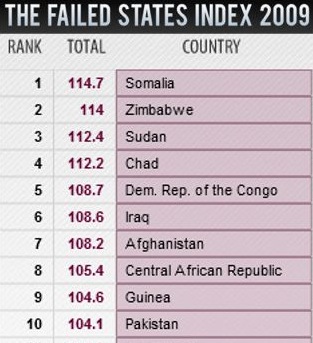Foreign Policy magazine has just released its annual Failed States Index (it comes with an excellent interactive map which you can use to get the ranking of every country in the world). The index is constructed by rating a number of different criteria including demographic pressures, economic decline, public services, and human rights. Coming in at first place for the second year running is Somalia. Yay, Somalia! I guess when your main source of income is derived from piracy, you can’t expect much better.
Foreign Policy magazine finishes its article with the following paragraph, part of which points out that the ratings should be used as “a starting point for a discussion” about what should be done about failed states:
The Failed States Index does not provide all the answers, nor does it claim to be able to. But it is a starting point for a discussion about why states fail and what should be done about them—a discussion, sadly, that we might be having even more frequently this year.
So, a discussion question, then, to kick things off. Should the presence of failed states concern us much?
I tend to think probably not, because history shows that states can move from stability to failure and back again really quite rapidly. Look at the disintegration of the Balkans or the USSR less than 20 years ago. Now, many of those newly independent countries are seen as relatively stable nations.
Or look at Rwanda and how quickly it has bounced back after the genocide in 1994 – it now sits in 48th place in the index, supposedly even less likely to fail than Egypt.
And one more example. Look at Kenya and how much it has fallen in the past four years, from 34th place in 2006 down to 14th this year. Corruption and famine can quickly push a state over the edge into anarchy.
So, following this up with a second question: Do failed states get a bad rap?
To this, I would say yes, particularly in recent history. I say this because failure may not be all bad. Sometimes countries need to fail badly so they can remake themselves, hopefully better and stronger. After all, back in the 1860s, the USA would probably have occupied first place on such an index for a number of years as it tore itself apart in civil war. Then it rebuilt itself….
We must also remember that the idea of a failed state is, historically speaking, quite a recent concept. It can only come into existence when we have an idea of what a whole, integrated or successful state might look like. And this idea only really starts to gain currency with the advent of organisations such as the United Nations.
The recent “panic” that surrounds the idea of a failed state arises after 9/11, mainly through fear that such places will become havens for terrorism. But let’s think about this a little more. Don’t you think it would be just as hard for a terrorist to try and survive inside a failed state as the rest of the populace? Turns out that this is, in fact, the case, as Foreign Policy has revealed:
Take Somalia, once again the No. 1 failed state on this year’s index. A recent report by West Point’s Combating Terrorism Center, drawing on captured al Qaeda documents, revealed that Osama bin Laden’s outfit had an awful experience trying to operate out of Somalia, for all the same reasons that international peacekeepers found Somalia unmanageable in the 1990s: terrible infrastructure, excessive violence and criminality, and few basic services, among other factors. In short, Somalia was too failed even for al Qaeda.
Too failed for Al Qaeda! Who would have thought? This means that instead of trying to save Afghanistan, the U.S. should be trying to make it worse. The Pakistanis would probably prefer this, as for them American intervention in Afghanistan has been a nightmare. Now, Pakistan has to deal with threats on several borders (instead of just the Indian border) as well as internal problems caused by Taliban and Al Qaeda entering the country to escape the Americans.
This destabilising effect is now reflected in the index, with Pakistan heading into the top ten. The law of unintended consequence at work here, perhaps?
Knowing what they know now, I’m sure the U.S. regrets not negotiating more with the Taliban back in 2001 in order to get them to hand over Osama bin Laden. It would have been less costly and less harmful to America’s standing in the Islamic world. And the failed state of Afghanistan would probably still be a failed state. Oh, that’s right, it is!
Filed under: Culture, Politics | Tagged: Afghanistan, Failed State, Foreign Policy, Pakistan, Politics, Somalia |



wow.. nice post
but.. how are these ‘states’? these are countries….
Hi Christina
State has pretty much become a synonym for country. Perhaps an abbreviation of nation-state?
If we’re talking about failed US states then California is probably leading at present 🙂
[…] piracy is no longer front-page news, it is still alive and well, with the ocean around the world’s no.1 failed state, Somalia, still the global hot […]
somalia isnt a failed state ,,,bt is y best film s take place.
there r 3 piracy in the world .1st is U.S.A in the air ,2nd is russia piracy in land , n 3rd is somalia piracy in ocean.
so in that somalia is among the best countries in the world.
ROFLMAO
This is the funniest comment i’ve seen today! Abdi, i politely request you contribute more of your fascinating thoughts…
[…] Yemen, you don’t even rank in the Top Ten Failed States so get you’re act together and deal with […]